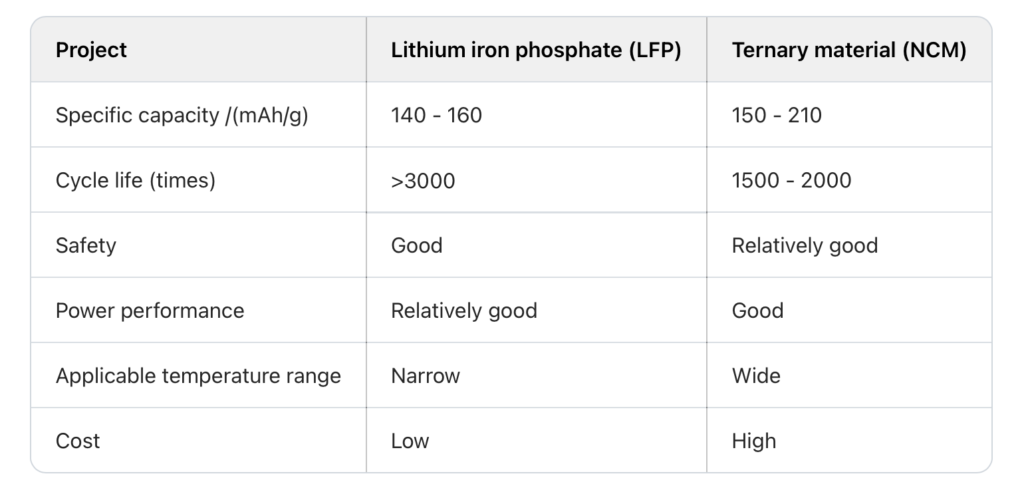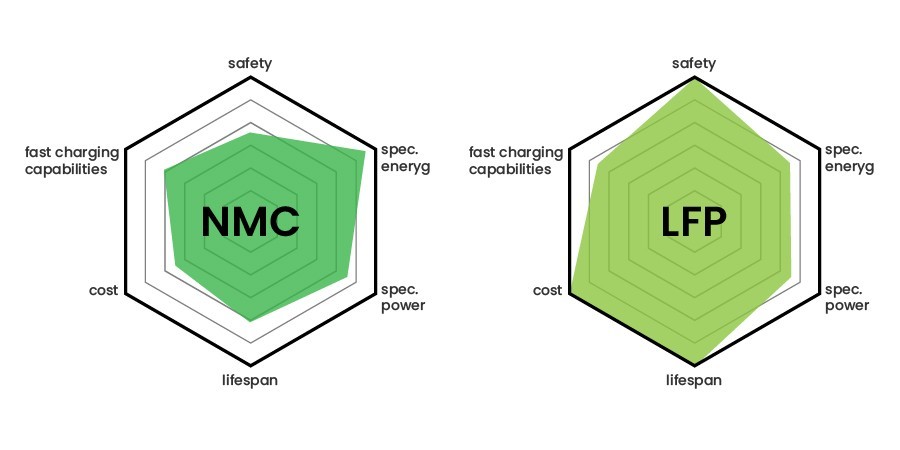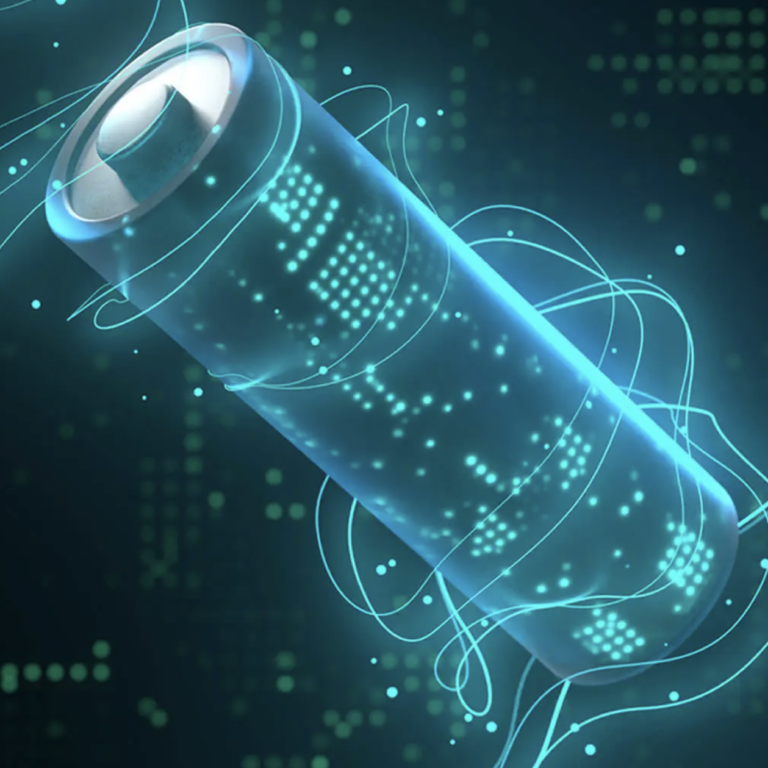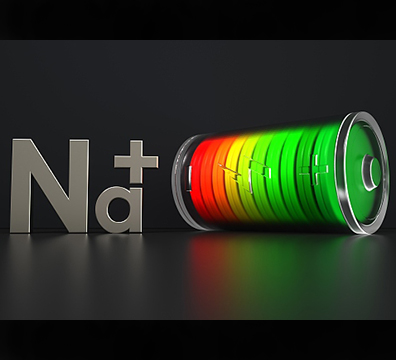LFP VS NMC! Comparative analysis of materials and batteries.
- Lithium Iron Phosphate (LiFePO₄) Materials and Batteries
LiFePO₄ with a three – dimensional network olivine structure forms a one – dimensional Li⁺ transport channel, which restricts the diffusion of Li⁺; at the same time, the octahedral FeO₆ are connected at the common vertex, resulting in its low electronic conductivity and large polarization during high – rate discharge. In order to solve the problems of low lithium – ion diffusion and electronic conductivity of LiFePO₄ materials, current technologies mainly improve them through means such as nanocrystallization, carbon coating, and doping. The charge – discharge process of LiFePO₄ materials mainly involves the mutual transformation between LiFePO₄ and FePO₄ phases, with a small volume change rate, making the material extremely stable. Therefore, the safety and stability of lithium iron phosphate materials and batteries are beyond doubt.
Figure 1 Structural model diagram of lithium iron phosphate materials
Lithium iron phosphate batteries mainly have the following characteristics:
(1) Lithium iron phosphate batteries have excellent cycle performance. The cycle life of energy – type batteries can be as long as 3,000 – 4,000 times, and the cycle of rate – type batteries can even reach tens of thousands of times.
(2) Lithium iron phosphate batteries have excellent safety performance. They can maintain a relatively stable structure even at high temperatures, making lithium iron phosphate batteries safe and reliable. Even when the battery is deformed or damaged, no safety accidents such as smoking or fire will occur.
On the other hand, the raw materials of lithium iron phosphate are relatively abundant, which greatly reduces the use cost of materials and batteries. At the same time, because iron and phosphorus elements are environmentally friendly, lithium iron phosphate materials and batteries are pollution – free to the environment. However, the structural characteristics of LiFePO₄ materials determine that the materials have low ionic and electronic conductivities. Moreover, as the temperature decreases, both the electron transfer impedance and the charge transfer impedance increase rapidly, resulting in poor low – temperature performance of its batteries. - Ternary Materials and Batteries
Since the Li(NiₓCoᵧMn₁ – ₓ – ᵧ)O₂ material was first reported, it has attracted great attention from researchers. In order to reduce the cost pressure caused by the price increase of Co, research on ternary materials with low Co or even no Co has been carried out at home and abroad, and such materials may become the mainstream cathode materials in the future.
Li(NiₓCoᵧMn₁ – ₓ – ᵧ)O₂ has similarities with the structure of LiCoO₂. Taking the NCM111 – type ternary material as an example, Li⁺ is located at the 3a position in the structure, Ni, Mn, and Co are randomly distributed at the 3b position, and the lattice oxygen occupies the 6c position. The transition – metal – layer structure is composed of Ni, Mn, and Co, and is surrounded by six lattice oxygens to form an MO₆ (M = Ni, Co, or Mn) octahedral structure, and lithium ions are inserted between the MO₆ layers. During the charge – discharge process, lithium ions are inserted and extracted between the MO₆ – layer structures, and the redox couples participating in the electrochemical reaction are Ni²⁺/Ni³⁺, Ni³⁺/Ni⁴⁺, and Co³⁺/Co⁴⁺, while the Mn element is electrochemically inert and does not contribute to the electrochemical capacity.
Figure 2 Structure diagrams of ternary materials without (a) and with (b) Li/Ni mixing
According to the proportion of Ni content, ternary materials and batteries can be divided into conventional – type and high – nickel – type. With the increase of Ni content, the amount of lithium that can be inserted and extracted increases, and the material capacity and battery energy density increase. Therefore, high – nickel – type ternary materials and batteries are currently a hot and challenging research topic.
First, because the radius of Ni²⁺ is very close to that of Li⁺, as the Ni content increases, the probability of Li/Ni mixing in high – nickel ternary materials during high – temperature sintering preparation increases sharply, and the extraction and insertion of lithium entering the MO₆ layer are relatively difficult, which hinders the Li⁺ transport capacity, resulting in a decrease in specific capacity and cycle performance that is difficult to reverse.
Second, as the Ni content increases, the proportion of Ni³⁺ in the material also increases, and Ni³⁺ is very unstable. When exposed to air, it is very easy to react with moisture and CO₂ in the air to form surface residual alkali, resulting in a loss of capacity and cycle performance of ternary materials. In addition, excessive surface residual alkali will cause severe gas production in ternary batteries, affecting their cycle performance, safety performance, etc.
Third, the high – valence Ni element also has high catalytic activity and oxidizability, which causes electrolyte decomposition and also causes battery gas production. In order to solve the above problems, precursor customization, personalized sintering processes, ion doping, surface coating modification, wet – treatment, and production environment control have become common choices for ternary material manufacturers.
For ternary batteries, their performance characteristics mainly include high material mass – specific capacity, mass and volume – specific energy, good rate performance and low – temperature performance. However, due to the stability of the structure, the scarcity of nickel – cobalt resources, etc., their cycle performance is good, their safety performance is average, and their cost is high. - Comparative Analysis of the Two Materials and Batteries
3.1 Energy Density
Compared with lithium iron phosphate materials, ternary materials have a higher discharge specific capacity and a higher average voltage. Therefore, the mass – specific energy of ternary batteries is generally higher than that of lithium iron phosphate. In addition, due to the low true density, small particles, and carbon coating of lithium iron phosphate materials, the compaction density of its electrode is about 2.3 – 2.4 g/cm³, while the compaction density of the ternary electrode can reach 3.3 – 3.5 g/cm³. Therefore, the volume – specific energy of ternary materials and batteries is also much higher than that of lithium iron phosphate.
3.2 Safety
From the perspective of safety, the main structure of lithium iron phosphate materials is PO₄, and its bond energy is much higher than the M – O bond energy of the MO₆ octahedron in ternary materials. The thermal decomposition temperature of fully – charged lithium iron phosphate materials is about 700 °C, while the corresponding thermal decomposition temperature of ternary materials is 200 – 300 °C. Therefore, lithium iron phosphate materials are safer. From the perspective of battery comparison, lithium iron phosphate batteries can pass all safety tests, while ternary batteries cannot easily pass tests such as acupuncture and over – charging, and need to be improved from the structural parts and battery design ends.
3.3 Power Performance
The activation energy of Li⁺ in lithium iron phosphate materials is only 0.3 – 0.5 eV, resulting in its Li⁺ diffusion coefficient in the order of 10⁻¹⁵ – 10⁻¹² cm²/s. The extremely low electronic conductivity and lithium – ion diffusion coefficient lead to the poor power performance of LFP. The Li⁺ diffusion coefficient of ternary materials is about 10⁻¹² – 10⁻¹⁰ cm²/s, and the electronic conductivity is high. Therefore, ternary batteries have better power performance.
3.4 Temperature Suitability
Affected by the low electronic conductivity and ionic conductivity of lithium iron phosphate materials, the low – temperature performance of lithium iron phosphate batteries is poor. When lithium iron phosphate batteries are discharged at – 20 °C, the capacity retention rate is only about 60% compared with that at room temperature, while the ternary batteries of the same system can reach more than 70%.
3.5 Cost and Environmental Factors
Ternary materials contain scarce metals such as Ni and Co, and their cost is higher than that of lithium iron phosphate. With the improvement of material and battery technology levels, the costs of ternary and lithium iron phosphate batteries have both decreased significantly. Currently, the market price of ternary batteries is higher than that of lithium iron phosphate batteries. At the same time, compared with the environmentally – friendly Fe and P elements, the Ni and Co elements in ternary materials and batteries cause greater environmental pollution. Combining the above factors, the environmental control and waste recycling requirements for ternary materials and batteries are more urgent.
Table 1 Comprehensive comparative analysis of lithium iron phosphate materials and ternary materials
It can be seen from Table 1 that lithium iron phosphate materials and ternary materials each have their own advantages, which also determine their respective application fields.








